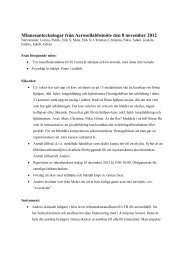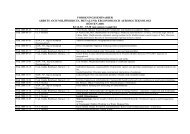ESTIMATING CLOUD DROPLET EFFECTIVE RADIUS ... - CAST
ESTIMATING CLOUD DROPLET EFFECTIVE RADIUS ... - CAST
ESTIMATING CLOUD DROPLET EFFECTIVE RADIUS ... - CAST
- No tags were found...
You also want an ePaper? Increase the reach of your titles
YUMPU automatically turns print PDFs into web optimized ePapers that Google loves.
<strong>ESTIMATING</strong> <strong>CLOUD</strong> <strong>DROPLET</strong> <strong>EFFECTIVE</strong> <strong>RADIUS</strong> FROM SATELLITE REFLECTANCE DATAModified Exponential Approximation___________________________________________________________________________________________________the asymmetry parameter g, which denotes the relative strength of the forward scattering(Liou, 2002, p. 105; Kokhanovsky, 2006, p. 96):1c11g = = P(cosθ)cosθdcosθ3 2∫(2.4)−1Even with the help of computers, it is not a simple task to derive the Legendre polynomials P land the expansion coefficients c l from the Mie theory. Therefore an approximate analyticexpression of the phase function may be desirable as an alternative to the numerical methods.One such approximate equation that has been widely used is the Henyey-Greenstein phasefunction, where the phase function is expressed in terms of the asymmetry parameter g(Mishchenko et al., 1999; Liou, 1992, p. 127);pHG=(1 + g22(1 − g )− 2gcosθ)3 / 2=N∑l=0l(2l+ 1) g P (cosθ)l(2.5)The Henyey-Greenstein phase function is best suited for the case where the forward scatteringis less pronounced, i.e. for smaller size parameters, and one should bear in mind that one ofthe main features for light scattering by aerosols and cloud droplets is strong forwardscattering. Kokhanovsky (2004a) derived an approximate equation for the phase function,where the forward scattering peak is much stronger than in the Henyey-Greenstein-function,and where the smaller peak at 145° is distinguishable. This was used for retrieval of cloudmicrophysical properties and is given by:p(52−C⋅θ−βi( θ −θi)θ ) = Qe + ∑bie(2.6)i=1where Q = 17.7, C = 3.9. p is used instead of P to indicate that the method is anapproximation. b i , β i and θ i are derived by parameterization of Mie theory results, values aregiven in Table 1 below (Kokhanovsky, 2004a; Kokhanovsky et al., 2003).Table 1 Parameters b i , β i and θ i for approximate phase function(Kokhanovsky, 2004).i b i β i θ i1 1744.0 1200.0 0.02 0.17 75.0 2.53 0.30 4826.0 pi4 0.20 50.0 pi5 0.15 1.0 piFigure 1 illustrates the difference between the Henyey-Greenstein phase function (Eq. (2.5))and the approximate phase function by Kokhanovsky (Eq. (2.6)). The drawback of theKokhanovsky equation is that it does not account for the influence of the size parameter onthe phase function. It is merely an approximation for all clouds, with no dependence oneffective radius, optical thickness or even wavelength, but has proven to be useful when5




